#indy roadster
Explore tagged Tumblr posts
Text
Happy to announce that X AE A-12 will make its World Premiere at the Yucca Valley Film Festival on Saturday, 11-11-23.
All screenings and activities are free. If you're in the desert this weekend (Coachella Valley or the high desert) swing by, say hey, and check out our little film.
We filmed X AE A-12 in Joshua Tree, so it feels really right to be making our public debut right down the road (Twentynine Palms Highway) in Yucca Valley.
https://www.xaea-12movie.com/

#yucca valley film festival#X AE A-12#indie films#yucca valley#tesla#tesla roadster#XAEA12movie#film festival
0 notes
Photo










International Sports Car Racing Day
International Sports Car Racing Day celebrated on the third Saturday of March every year is the day to celebrate and enjoy this extremely famous, international sport called sports car racing. This year it falls on March 18. Did you know that this day coincides with the 12 Hours of Sebring sports car endurance race? Yes, International Sports Car Racing Day is celebrated on the same day as the endurance race held in Sebring, Florida, at the International Raceway. The 12 Hours of Sebring, 24 Hours of Daytona, and 24 Hours of Le Mans were widely considered the trifecta of sports car racing. So, let us learn about the history, significance, and some interesting facts about this awesome day.
History of International Sports Car Racing Day
To give a little history about sports car racing, it is one of the main types of circuit auto racing that utilizes sports cars that have two seats and enclosed wheels. The 12 Hours of Sebring is an annual motorsport endurance race for sports cars that is popular globally.
It is held at Sebring International Raceway, on the site of the former Hendricks Army Airfield airbase in Sebring, Florida. During the initial years, the event was the second round of the World Sportscar Championship (now discontinued), I.I.M.S.A. G.T. Championship, and American Le Mans Series. Today, this event is the second round of the WeatherTeach SportsCar Championship.
The Sebring track was initially opened in 1950 on an airfield. It is technically a road racing course that took inspiration from the track used in European Grand Prix motor racing. The first race that was held on this track was a six-hour race on New Year’s Eve in 1950. Later, after 14 months, the first 12 Hours Endurance Race was held in Sebring. The race starts during the day and finishes at night. Teams, sports car owners, and fans from across the globe would come to witness this exciting annual event, held on the 17-turn, 3.7-mile road course. To commemorate this extraordinary race, International Sports Car Racing Day was established in 2013. Let us celebrate this event!
International Sports Car Racing Day timeline
1950 The Track is Opened
The Sebring race track is opened in Florida.
1952 The First Sebring Race
The first Sebring Sports Car Endurance Race is held in Sebring.
1966 Criticisms Come Pouring In
The facilities and safety of the circuit are heavily criticized.
2020 The Pandemic Postpones the Race
The race is rescheduled due to the pandemic.
International Sports Car Racing Day Activities
Visit the race
Make it a party
Share the gift
The best way to celebrate International Sports Car Racing Day is by visiting the iconic Sebring track in Florida. Check out when the next race is and witness it in action.
Put on your favorite sports car t-shirt or sweatshirt and invite your friends and family over to watch the sports with you on television. Make it a rememberable party!
Sports car racing is one of the most exciting and impressive sports in the world. You might be a big fan, but your kids, friends, or colleagues might not know much about it. So, introduce them to the exciting world of sports car racing.
5 FACTS ABOUT SPORTS CAR RACING THAT WILL PUMP YOUR ADRENALINE
The rear wings are mostly show-off
Sports cars are fuel-efficient
They will not explode
Sports cars are not as loud
Touring cars were the inspiration
For sports cars moving at normal speed, rear wings prove to be of no use.
Modern-day sports cars take fuel efficiency seriously and are mostly fuel-efficient.
Unlike what most people think, sports cars are less likely to explode due to solid engineering.
Sports cars are not as loud and noisy as people think they are; they just produce a smooth hum.
The design of touring cars and roadsters was used as a basis for modern sports car designs.
WHY WE LOVE INTERNATIONAL SPORTS CAR RACING DAY
We all love to cheer
It is a fun event
It teaches us about life
Whether it is our friend who is participating in a race or our favorite sportsman who is behind the wheels, we all love to cheer! If you are a fan of this exciting sport, you can go to the racetrack and cheer for the team.
Sports car racing is a fun event, especially if it lasts 12 hours! Planning a trip with your friends and family and visiting the race is a fun event that you will remember for a lifetime.
One wonderful thing we can take home from International Sports Car Racing Day is the ability to endure. The 12-hour race teaches us the power and benefit of endurance in life.
Source
#Corvette SuperSport#Watson Roadster#National Corvette Museum#USA#Bowling Green#Kentucky#tourist attraction#landmark#indoors#travel#summer 2016#technology#engineering#original photography#vacation#Epperly Indy Roadster#International Sports Car Racing Day#18 March 2023#third Saturday in March#InternationalSportsCarRacingDay#Southeastern Region#Chevrolet Corvette
0 notes
Text

John Carpenter will release his fourth solo album, Lost Themes IV: Noir, on May 3 via Sacred Bones Records. The filmmaker/composer is, as always, accompanied by son Cody Carpenter on synthesizer and godson Daniel Davies on guitar.
The album is available to pre-order on vinyl in several colorways, each of which features a foil stamped jacket and comes with a 24x36 fold-out poster (pictured below):
Black ($20)
Red ($24)
Indie exclusive tan and black marble with bonus 7"
Sacred Bones exclusive red on clear splatter with bonus 7" ($30, limited to 1,000)
Rough Trade exclusive oxblood red and black splatter with bonus 7" ($33, limited to 300)
Shout Factory exclusive black and clear cloudy with bonus 7" ($32, limited to 500)
The album is also available on CD ($14) and cassette ($12). Watch the music video for a new song titled "My Name Is Death" below, where you can also read the press release.
youtube
It’s been a decade since John Carpenter recorded the material that would become Lost Themes, his debut album of non-film music and the opening salvo in one of Hollywood’s great second acts. Those vibrant, synth-driven songs, made in collaboration with his son Cody Carpenter and godson Daniel Davies, kickstarted a musical renaissance for the pioneering composer and director. In the years since, Carpenter, Carpenter, and Davies have released close to a dozen musical projects, including a growing library of studio albums and the scores for David Gordon Green’s trilogy of Halloween reboots. With Lost Themes IV: Noir, they’ve struck gold again, this time mining the rich history of the film noir genre for inspiration. Since the first Lost Themes, John has referred to these compositions as “soundtracks for the movies in your mind.” On the fourth installment in the series, those movies are noirs. Like the film genre they were influenced by, what makes these songs “noirish” is sometimes slippery and hard to define, and not merely reducible to a collection of tropes. The scores for the great American noir pictures were largely orchestral, while the Carpenters and Davies work off a sturdy synth-and-guitar backbone. The noir quality, then, is something you understand instinctively when you hear it. “Some of the music is heavy guitar riffs, which is not in old noir films,” Davies notes. “But somehow, it’s connected in an emotional way.” The trio’s free-flowing chemistry means Lost Themes IV: Noir runs like a well-oiled machine—the 1951 Jaguar XK120 Roadster from Kiss Me Deadly, perhaps, or the 1958 Plymouth Fury from John’s own Christine. It’s a chemistry that’s helped power one of the most productive stretches of John’s creative life, and Noir proves that it’s nowhere near done yielding brilliant results. “This is who we are, I think,” John summarizes. “Daniel’s the adventurer. He pushes for new sounds, new directions. He tries things that I haven’t thought of. He’s a lot more daring than I am, and he enriches the whole thing. Cody’s the musician. He’s a savant at music. He understands music. We depend on him to rescue us.” And what about John’s contribution? With characteristic understatement, he concludes: “I’m the experience. I’ve done music for movies before.”

#john carpenter#cody carpenter#daniel davies#synthwave#film noir#lost themes#noir#sacred bones records#vinyl#gift#horror#halloween#escape from new york#the thing#they live#80s horror#Youtube
16 notes
·
View notes
Text






1962 INDY MCGEE/CARMEN ROADSTER RACE CAR
4 notes
·
View notes
Text

Bill Vuković, poznati crnogorsko-američki vozač, rođen je 13. decembra 1918.
Niko u istoriji trke Indy 500 nije uspeo da je osvoji tri godine zaredom. Najbliži trostrukoj pobjedi bio je Bill Vuković, možda najveća legenda trke, koji ju je osvojio 1953. i 1954. godine.
Bill Vuković, poznati crnogorsko-američki vozač, rođen je 13. decembra 1918. godine u Fresnu (Kalifornija). Poginuo je u Indianapolisu 30. maja 1955. u bizarnoj nesreći koju nije mogao izbjeći dok je vodio trku.
Iako mu je nadimak bio Ludi Rus , ovaj fantastični vozač zapravo je bio prva generacija crnogorskih doseljenika rođenih u Americi, porijeklom iz sela, možemo reći, šireg dubrovačkog zaleđa, sjeverozapadno od Boke Kotorske, a pravo ime mu je bilo Vaso Vučurović!
Njegove pobjede omogućio je vjerovatno najgenijalniji konstruktor, tzv roadster iz ere Indy trkaćih automobila Frank Kurtis , čiji su automobili od 1950. do 1955. pobijedili čak pet puta. Kurtis je bio i prva generacija doseljenika rođenih u Americi, ali je rođen kao Hrvat, iz malog sela Razdrto u Gorskom kotaru, a pravo mu je ime Franjo Kuretić!
Bill Vuković je karijeru započeo u popularnim trkama tzv 'patuljci', koji su bili i glavni izvor kasnije kreme najboljih vozača na ovalnim stazama. Karijeru je započeo s timom Edelbrock, još uvijek jednim od najpoznatijih američkih proizvođača dodatnih dijelova za automobile visokih performansi. Krajem 1940-ih dominirao je kalifornijskom trkačkom scenom, a nakon što je prešao u najviši rang, pokorio je Ameriku poput munje.
Ilustracije radi: vozio je ukupno 676 krugova u trci Indy 500, od ��ega je u vodstvu proveo nevjerovatnih 485 krugova! Vuky je, po mnogima, najveći američki trkač svih vremena, a u skladu sa tadašnjom tradicijom i njegov sin i unuk bili su trkači, ali nikada nisu dostigli njegov nivo uspeha.
Bill Vuković, poznati crnogorsko-američki vozač, poginuo je 30. maja 1955. na stazi u Indijanapolisu .
youtube
1 note
·
View note
Text

The Kurtis Indy Roadster was 3rd in the Bob Gerard & Robert Ashley Trophies Race, Mallory Park. Report on the VSCC meeting in the current Issue of Classic and Competition Car magazine. Free to read at www.classcompcar.com
#THEVSCC#VSCC#Vintage Sports Car Club#MalloryPark#Motorsport#Silverstone#Cars#Classic Cars#1950s#motoracing
1 note
·
View note
Photo




Indy Roadster built in 1963 driven by Johnny Rutherford. It’s last Indy run was 1966.
21 notes
·
View notes
Photo


1963 Watson Indy Roadster
7 notes
·
View notes
Photo










Indy-raced 1961 San Diego Steel Products roadster for sale on Hemmings.com.
#Indianapolis 500#Indy 500#Indy roadster#Sixties#San Diego Steel Products Indy roadster#vintage racing#motorsports
25 notes
·
View notes
Photo

NOW LIVE for Monthly and Premium Subscribers. Paul Mooney's Track T, a dedication to his father, Fey Mooney, and the Mooney/Simkins 1932 @Ford #ModelT #Roadster. The original car was featured in the January 1950 issue of #HotRodMagazine, in Dick Wallen's Roaring Roadsters: The Road to #Indy, and winning its class at the second ever Oakland Roadster Show in 1950. @imagestreetrods has recreated this car for Paul to near historic accuracy with an original 1926 Model T with #allmetal hand work. It was built solely by pictures and the few details they could find on the original #TracT. See the feature here: https://www.carbageonline.com/a-trac-tive-paul-mooneys-1926-model-t-roadster/ If you're not a subscriber, you won't see this for two weeks so sign up now at https://www.carbageonline.com/membership-account/membership-levels/ (at Carbage)
1 note
·
View note
Photo

1959 Kurtis Indy Roadster
15 notes
·
View notes
Photo










International Sports Car Racing Day
As its name implies, International Sports Car Racing Day is a day to enjoy and appreciate this hugely popular sport on a global level. This day is designated on the perfect day. This day coincides with the 12 Hours of Sebring sports car endurance race held in Sebring, Florida at the Sebring International Raceway. It is America's oldest sports car endurance race. The race was started in 1952 on the grounds of what is now the Sebring Regional Airport.
Teams, fans and sports car owners from all over the world come to be a part of the annual event, held on the 17-turn, 3.7 mile road course. This race is the opening round of the American Le Mans Series.
If you can't get to the raceway, watch it on television.
Make it a party! Put on your favorite sports car t-shirt or sweatshirt. Invite your friends over to watch it with you. And, make snacks to enjoy during the game.
Origin of International Sports Car Racing Day
While it is clear why this day was established, our research has not yet identified the creator. This holiday appears to have started around 2013.
Source
#International Sports Car Racing Day#InternationalSportsCarRacingDay#USA#third Saturday in March#21 March 2020#original photography#summer 2016#National Corvette Museum#Bowling Green#Kentucky#Corvette SuperSport#Hurst Floor Shift Special#Watson Roadster#Kurtis Kraft 2000#Newman Haas Racing Car#Epperly Indy Roadster#Kurtis Kraft 500b#Luzern#Swiss Transport Museum#Verkehrshaus der Schweiz#Carmel-by-the-Sea
2 notes
·
View notes
Text
The Troy Indy Special Prototype Is For Sale
The Troy Indy Special Prototype Is For Sale #hotrod #indycar #customcar #racecar #classiccar #vintagecar #car #cars #cardesign #sportscar
This is the prototype of the Troy Indy Special, a new limited production car from the team at 7fifteen Motorworks that is essentially a reengineered 21st century version of the one-off Troy Custom Roadster from 1959. The original Troy Custom Roadster was developed by Wally Troy, a popular custom car builder in the 1950s, to be a cross between an Indy car and a hot rod – taking the best design and…

View On WordPress
2 notes
·
View notes
Photo


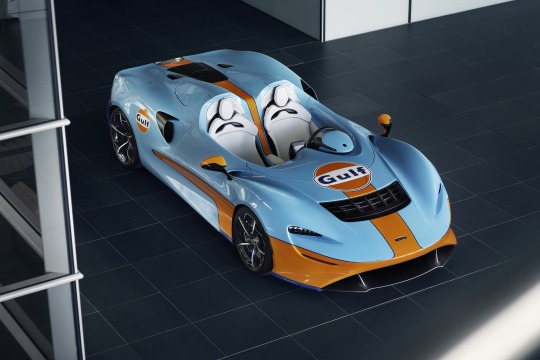


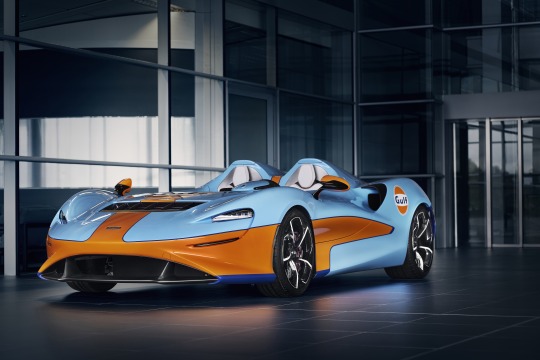
Gulf Themed McLaren Elva Debuts at Goodwood
Luxury supercar maker McLaren Automotive today premieres the McLaren Elva Gulf Theme by MSO, a celebration of the renewed relationship between McLaren and the Gulf Oil brand and another example of how designs from McLaren’s racing history are inspiring the brand’s modern-day customers.
The unique McLaren roadster in blue and orange Gulf colors makes its world debut at Goodwood SpeedWeek, a ‘closed-doors’ live broadcast event bringing together the past, present and future of motoring and motorsport at the Goodwood Motor Circuit in the UK.
McLaren and Gulf recently confirmed a new partnership that renews a historic union between the two brands that originated in the 1960s, a decade when both companies made their first forays into motorsport. Gulf branding appeared on McLaren’s Can-Am, Formula 1 and Indy cars from 1968 to 1973. Two decades later McLaren F1 GTRs run by customer team GTC carried the famous Gulf livery in global GT racing, including at Le Mans.
Under the new partnership, McLaren Automotive customers will have the opportunity to commission Gulf-liveried cars directly from MSO. These follow cars inspired by the famous facing livery designed and produced by MSO prior to the renewed relationship being agreed. Most recently, a McLaren Senna GTR LM paying homage to the #24 McLaren F1 GTR that finished fourth in the 1995 24 Hours of Le Mans race was completed as one of five MSO-designed customer cars celebrating the McLaren F1’s domination of that race.
The Elva, which follows the McLaren P1, McLaren Senna and Speedtail in McLaren’s Ultimate Series, links McLaren’s heritage to its present and future with a name and style that recalls the McLaren-Elva sports racers of the 1960s. These were among the first sportscars designed and raced by Bruce McLaren and the company he founded, and the new Elva evokes the true spirit of driving enjoyment symbolized by this era.
In line with McLaren’s on-going commitment to super-lightweight engineering, the new Ultimate Series roadster retains the lightweight construction philosophy of its forebear and is at the cutting-edge of automotive technology. The body design of the screenless, roofless Elva, for example, incorporates an innovative Active Air Management System (AAMS) that creates a virtual canopy over the seamlessly-integrated cockpit. The 815PS and 800Nm developed by the 4.0-litre, twin-turbocharged V8 engine ensure that the Elva delivers astonishing performance and incredible levels of driving enjoyment.
With deliveries of the Elva commencing this year, MSO has already completed the specification of the first cars and is well-advanced in discussions with customers to create further dramatic paintwork and liveries. Just 149 examples of the Ultimate Series roadster will be available to customer order, making it one of the rarest McLarens ever produced and, with an almost-limitless degree of personalization available from MSO, each car will have its own unique identity.
165 notes
·
View notes
Text
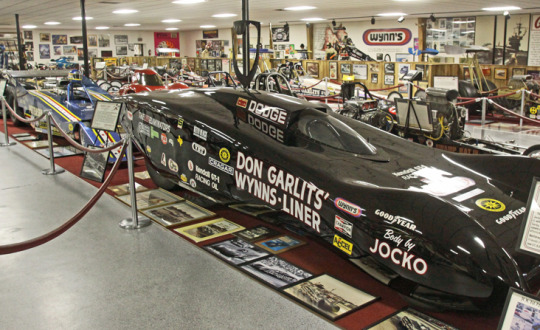
The story of Swamp Rat 17: Don Garlits' most misunderstood Top Fueler (part 2)
The Wynn’s Liner sits proudly in Garlits museum, parked just ahead of Petersen’s own failed attempt at aerodynamics, the Can Am-inspired Olympia Top Fuel car that lived its own all-too-short life in 1974.
Any chat with Don Garlits is always a thrill, but for history geeks like me, it’s especially thrilling because of his incredible memory. He turned 89 in January, but his memory is as clear as if he were 29. He, of course, knows his cars inside out, remembering specifically not only the number of each Swamp Rat but wheelbases, engines, and great stories associated with each. I do a lot of interviews with the stars of yesteryear and many, many of them, quite naturally as they age, have less than excellent recall. Then there's "Big Daddy." He's amazing.
So, as promised earlier in this column, I asked him to rank his Swamp Rats in order of favorites. Although I'm sure that, given time, he could have ranked them from 1 to 38, I asked only for his Top 5.
Here’s his Top 5, including portions of the descriptions I wrote for my trio of Swamp Rat Spotters Guides a few years ago (Swamp Rats I-A to X | Swamp Rats XI to 20-B | Swamp Rats 21 to 34):

No. 1, the first (1956-60): Although it wasn't his first dragster — he had made a crude, flathead-powered dragster from a '27-T roadster by moving the engine back and hanging a seat out over the rear end — it's the first car to wear the Swamp Rat name. The car was built on the framerails of a '31 Chevy passenger car that he bought at a junkyard for $35 in 1956; Garlits removed the frame from the body in the junkyard using little more than a large ax, a cold chisel, a ball-peen hammer, and a small assortment of hand tools. He transplanted most of the parts off of the flathead dragster to this car, except the driver seat, which was an old B-17 bomber seat. Initially using Ford power, Garlits switched to Chrysler Hemi power and later to high-gear-only. The carbureted version of this car is the one that beat the nay-saying Californians in Houston but got whipped by the West Coasters in Bakersfield, but as soon as "Big" added a blower, it was all over for everyone.
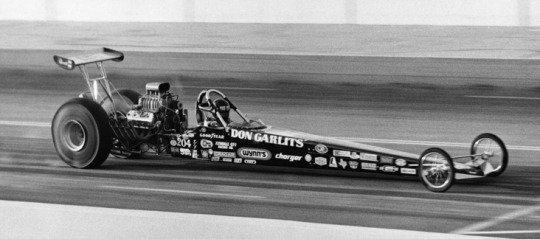
No. 22, the 5.63 car (1975): The car that succeeded SR 21 would go into the record books in a "big" way and stay there for years: This is the car in which Garlits brought the class to its knees with a 5.63-second clocking at the World Finals, a record that stood for more than six years. Built by Garlits, “T.C.” Lemons, and Don Cook on a 240-inch wheelbase, the car was lightweight and fast from the first go. He had hoarded oversized Goodyear slicks, built a new engine, and even lengthened the chassis by 10 inches, and it all paid off with that monstrous 5.63 that helped him win the event and the championship and was attached to the sport's first official 250-mph run. The historic car was retired at year's end and has never left Garlits' possession other than for occasional displays; it was hauled out of mothballs to run at — and win — the 1977 Gatornationals.
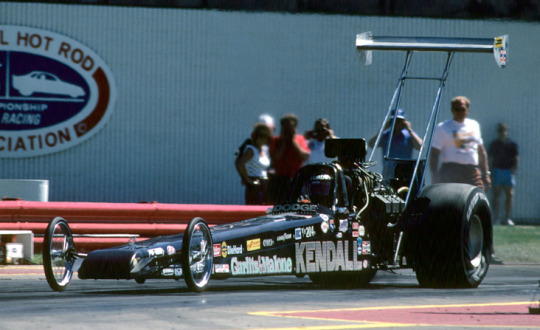
No. 26, the comeback car (1980-84): The follow-up to the porky “Godzilla” car, Swamp Rat 26 was "lean and light" — Garlits forsook paint for black anodized panels with stick-on lettering — and with the power that Garlits and Parks had learned to make to get the porky Godzilla car down the track, they seemed to be ahead of the game. The car was completed in time to run the Florida Winter Series events, but Parks quit that winter after the tough 1980 season, and Garlits won just two AHRA events in 1981. Garlits ran infrequently in the next three seasons, and Swamp Rat 26 might have just gone quietly into retirement as a disappointment had old pal Art Malone not called Garlits in the summer of 1984 and offered to fund a run at the 1984 Indy title. Malone got Garlits new parts, and they coaxed Parks out of retirement, and despite an aging car and a team of "dinosaurs" (Garlits' word), they won the race, completing a storybook comeback straight out of Hollywood. Garlits went on to also win a big eight-car Top Fuel show at Firebird Int'l Raceway and the NHRA World Finals — "Big Daddy" was back!
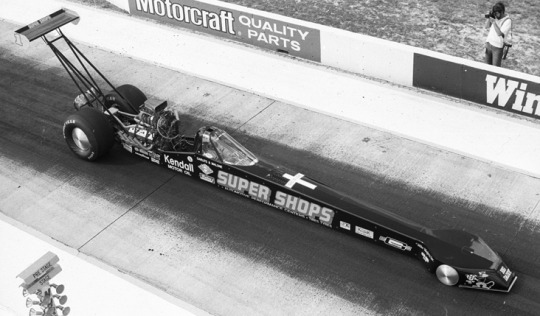
No. 30, the streamliner (1986): In the pantheon of famous Garlits cars, this cockpit-canopied streamliner may well be at the top of the pyramid. Garlits had Mike Magiera fabricate the nosepiece and constructed front "tires" out of 13-inch aluminum discs wrapped with industrial fan belts to fit beneath it. The belts would exit the wheels after almost every run, but that didn’t stop the “Rat Under Glass” from running 272.56 mph in the car's winning debut in Gainesville in 1986. Garlits later abandoned those wheels to run small-airplane tires that worked well but, ironically, took flight in his famous July 12 blowover wheelstand at the NHRA Summernationals. The car had to be backhalved in the Florida shop to complete the season, which ended with Garlits atop the points standings. Swamp Rat XXX also ran about half of the 1987 campaign and then famously became part of a display at the Smithsonian Institution the following year.
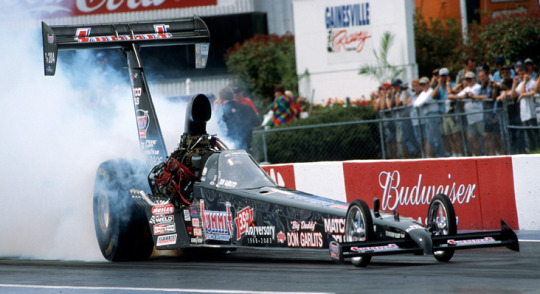
No. 34, the monowing car: Originally built in 1992 for Bruce Larson to drive after Garlits retired after experiencing eye problems caused by too many sudden parachute decelerations. At the end of the 1994 season, Garlits loaned the car to former Funny Car and fuel altered pilot Richard Langson and served as his crew chief in 1995, albeit with little success again. After years off the track, Garlits brought the car up to spec and competed at the 2002 Gatornationals and U.S. Nationals, then upped his speed mark to 323.04 at the 2003 Gatornationals. “It’s still the most modern Top Fueler in the world,” Garlits insisted to me. “It’s got the narrowed rear end and the mono wing rudder to make it go straight down the course, and the canopy.”
And, well, because Garlits was being so generous with his time and candor, I dared to ask him about his bottom five.

“Well, only a half-dozen cars that didn’t cut the mustard, but from what we’ve already talked about today," he said. "I think you know the five already: the streamliner (SR17), ‘Shorty' (SR18), the sidewinder (SR27), the turbine car (Swamp Rat 28-A), and then it would be Swamp Rat 12-A. That car [pictured above, was the first Swamp Rat to be designated with Arabic numerals instead of Roman numerals] was too short [just 137 inches], and we only ran that in the winter series in California."

My Spotters Guides from a few years ago ended at 34, but the numbers carried on after
35: 2009 DragPak stocker
36: 2011 Drag Pak stocker
37: First electric car
38: Second electric car
Swamp Rat 38 had been Garlits' hope for being the first battery-powered car to exceed 200 mph, but he was beaten to that mark last year by Steve Huff and parked the car.So, naturally, I had to ask Garlits if there would ever be a Swamp Rat 39.“Never say never,” he said, and I could detect a gleam in his eye even over a cellular connection. “Maybe I try to build a 250-mph electric car. There’s such fantastic battery technology coming, I don’t want to spend money on old technology. I still want to drive if I can by then. I still feel good, so I don't think that will be any problems.”Same ol' "Big Daddy." I can’t wait.Phil Burgess can reached at [email protected] of more articles like this can be found in the DRAGSTER INSIDER COLUMN ARCHIVE
18 notes
·
View notes
Photo







Big Boy’s Toys 25 December 2021 The Norman Timbs Special
The Norman Timbs Special is a homebuilt Sport Custom built by Norman Timbs over a span of three years. Norman's streamlined custom was supposed to be a prototype for a limited series of cars reflecting advanced concepts in performance and aesthetics. Being an automotive engineer working with Preston Tucker on his Tucker Automobiles and on several Indy cars, Norman made comprehensive chassis drawings that led to 1/4 scale clay models of several body ideas. The models led to a wooden model incorporating the favored elements. Norman handmade an aluminum body for the car by forming panels on the wooden pattern. The panels were then welded together. The chassis was made of welded aircraft tubing. The car was 17 1/2 feet long with a 117 inch wheelbase, 56-inch thread, and a weight of 2 500 pounds. It was powered by a 1948 Buick Straight 8 engine located just behind the driver's seat. Steering, brakes and other equipment were standard Mercury. The rear body on the car was hinged to raise hydraulically for access to the engine compartment, fuel tank and spare tire. The fuel tank was placed between the wheels. The front hood covered a luggage compartment. In the rear, taillights from a 1939 Ford were installed. Without the windshield the car stood 39 inches tall. Total height with the windshield was 47 inches Total cost of the build was $10,000 according to Mechanix Illustrated September 1949. Once completed, Norman's Buick Special was featured on the cover of Motor Trend October 1949, the second issue of Motor Trend.
In 1954 the Norman's Buick Special was featured in Motor Life February 1954. By then the car had been painted white. it was currently owned by Air Force Officer Jim Davis of Manhattan Beach, California. The article stated that the car was the brain-child of former aircraft manufacturer Larry Timm. According to the story Larry designed and built the car over a three year period ending in 1948. Davis bought the car in 1952 and was, according to the story, the first person to have the car registered for road use. Norman's Buick Special was featured in an episode of Buck Rogers.
For several years the car was parked away in the hot California desert. In 2000 it was featured briefly in the Nicholas Cage movie Gone in 60 Seconds. 2 years later, In 2002 it was auctioned away by Barret Jackson at the Petersen Museum Classic Car Auction. The sales price was $17,600.00 USD. Collector Gary Cerveny was the lucky bidder. Gary began to restore the car himself, before he decided to hand it over to Custom Auto of Loveland, Colorado, and let them complete it. Before Gary handed the car over to Custom Auto he repaired the wheel wells, grille opening and drive train. The car was about 90% original when Gary acquired the car. The body halves had been bolted together, and access holes had been cut in for the rear wheels and the engine bay. In March of 2012 the restored version of the car made its debut at the Amelia Island Concours d'Elegance in Florida. At the show it won "The RM Auctions Trophy For the Best Open Car". Later on in 2010 Norman Timbs' Buick Special was hand picked to be part of the prestigious Customs Then and Now exhibit at the 2011 Grand National Roadster Show in Pomona, California, an elite gathering of the most historically significant customs in the world. In August of 2012 the car will also be competing in the Pebble Beach Concours d'Elegance, the world's premier celebration of the automobile. In 1997 the Pebble Beach Hot Rod Class was started. The Hot Rod Class has been featuring roadsters, coupes and pre-war customs in the past. The 2012 Hot Rod Class will be dedicated to Sport Customs and one offs such as the Arthur Bentas' Raven, the 1950 Saturn, the 1947 Kurtis Omohundro, the Maverick sportster, the Coachcraft Special and Vince Gardner's 1947 Studebaker.
2 notes
·
View notes